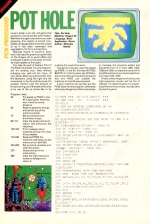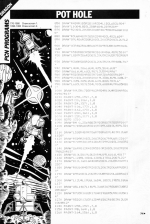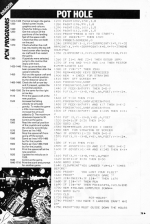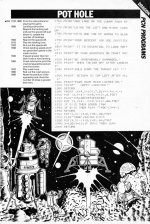
Personal Computer News
 4th February 1984
4th February 1984
Author: Nicholas Hewitt
Published in Personal Computer News #047
Pot Hole
Lunar Lander is an old, old game that comes on micros ancient and modern. Well here it is again, but before you start groaning, this version is almost completely unrecognisable from the original as it has been revamped and upgraded to the form printed here.
Nicholas Hewitt of Ayrshire, Scotland, has used the graphics capabilities of the Dragon 32 to good effect and produced a game not as easy to finish as might appear at first sight.
You take the part of Captain Pilot of The Fleet of six ships. You are responsible for landing your fleet without pranging any, well not too many, of your ships. Steering is done either with the keyboard, using the right and left arrow keys, or by the judicious use of a joystick. Control over the amount of thrust coming out of the back of the ship is by use of the up arrow key or by pushing the joystick forward.
The game originally used the speed up POKE, in line 40, this was 40 POKE &HFFD7,0. Unfortunately the PCN Dragon is one of the permanently slow kind and this POKE just crashed the machine, so line 40 was removed.
If your machine will go fast, put the POKE back into the program, otherwise either play the game a little more slowly or increase the amounts added and subtracted from X in lines 1480, 1500, 1590 and 1600, increase the value of V in line 250 and the amount subtracted from D in lines 1520, 1620.
Finally, when the game is first run, the high-resolution screen will be full of rubbish. To make the game run properly just follow the prompts; i.e. press a key to play the game.
Program Notes
| 40 | Put speed up POKE in line 40 if applicable. Note this won't work on some Dragons |
| 60 | Reserve space for strings and set the top of the memory pointer |
| 70 | Set up variables and dimension arrays |
| 80-110 | Clear the screen and print option. Get, and act on, the response |
| 120-160 | Print message about joysticks and wait for a key to be pressed |
| 170-240 | Read and POKE the machine code data into the memory from &H7000 |
| 250-260 | Set up some variables and clear the screen |
| 270 | Gosub and print the instructions |
| 280 | Clear the high-resolution screen to background colour 2 |
| 290-420 | Draw the spacecraft, the bust spacecraft and the equivalent background square and copy them into the appropriate arrays for later use |
| 430 | Clear the screen back to colour 2 |
| 440 | Select a random playing screen (and check that it's not the previous one) |
| 450 | Put the present screen number into RS |
| 460-470 | Jump the appropriate screen drawing routine |
| 480-760 | Draw screen 0 |
| 770-1080 | Draw screen 1 |
| 1090-1300 | Draw screen 2 |
| 1310-1320 | Prompt to begin the game |
| 1330 | Select screen mode |
| 1340 | Check for hitting a rock |
| 1350 | Get the colours of the positions of the landing feet of the space craft |
| 1360 | Check that they are both on the pad |
| 1370 | Check whether the craft has returned to the top left hand corner after landing six craft and if so restart the game |
| 1380 | If joysticks were selected, jump to the routine that deals with them |
| 1420-1440 | If the up arrow key has been pressed then alter the upward velocity |
| 1450 | Rub out the space craft and alter the vertical position by the distance value D |
| 1460-1480 | Check the left arrow key and if pressed update the horizontal position |
| 1490-1500 | Do the same for the right arrow key |
| 1510 | Print the space craft at the new position |
| 1520 | Increase the falling velocity to simulate gravity. To make the game a little more exciting, increase the amount added to D. The maximum downward speed is 30 |
| 1530 | Continue the game |
| 1560 | Read the vertical position of the joystick and update the velocity accordingly |
| 1570 | Same as line 1450 |
| 1580 | Stop the spacecraft from going off the screen |
| 1590 | Same as lines 1470-1480 but for the joystick |
| 1600 | Same as lines 1490-1500 but for the joystick |
| 1610 | Print the spacecraft at the new position |
| 1620 | Update the velocity as in 1520 |
| 1630 | Continue the game |
| 1640-1710 | Print the score and prompt for another game |
| 1720-1880 | Print the instructions for playing the game |
| 1890 | Landing subroutine. Repaint the landing pad and put the spacecraft just above it; update the number of landings |
| 1900 | Reprint the spacecraft |
| 1910 | Play the landing tune |
| 1920 | Rub out the spacecraft |
| 1930 | Check landing speed and if too great then gosub to the crash routine |
| 1940 | If speed greater than ten then it was a hard landing |
| 1960 | Crash subroutine print the crashed spaceship picture on the screen |
| 1970 | Play crash tune |
| 1980 | Rub out the crash picture |
| 1990 | Reset the position of the spaceship and check the number of ships is greater than zero |

This article was converted to a web page from the following pages of Personal Computer News #047.






